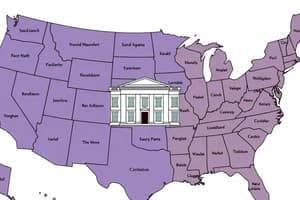Podcast
Questions and Answers
In a ______ system, states retain a considerable amount of sovereignty.
In a ______ system, states retain a considerable amount of sovereignty.
confederation
One challenge faced by federal systems is ______ disputes.
One challenge faced by federal systems is ______ disputes.
jurisdictional
The U.S. Constitution defines the powers of the federal and ______ governments.
The U.S. Constitution defines the powers of the federal and ______ governments.
state
The Tenth Amendment reserves powers not delegated to the federal government to the ______ or the people.
The Tenth Amendment reserves powers not delegated to the federal government to the ______ or the people.
The ______ Clause establishes the supremacy of federal law when in conflict with state law.
The ______ Clause establishes the supremacy of federal law when in conflict with state law.
In a ______ system of government, power is shared between a central government and regional governments.
In a ______ system of government, power is shared between a central government and regional governments.
The ______ government is responsible for matters of national concern, such as defense and foreign policy.
The ______ government is responsible for matters of national concern, such as defense and foreign policy.
______ governments are responsible for internal affairs within their respective territories.
______ governments are responsible for internal affairs within their respective territories.
The concept of ______ sovereignty highlights that both federal and state governments have independent powers.
The concept of ______ sovereignty highlights that both federal and state governments have independent powers.
A ______ constitution outlines the specific powers and limitations for each level of government.
A ______ constitution outlines the specific powers and limitations for each level of government.
The ______ system of government is characterized by a strong central government with limited regional autonomy.
The ______ system of government is characterized by a strong central government with limited regional autonomy.
The ______ model of federalism emphasizes a strong federal role and active collaboration with state governments.
The ______ model of federalism emphasizes a strong federal role and active collaboration with state governments.
The trend of ______ power from the federal government to states is known as New Federalism.
The trend of ______ power from the federal government to states is known as New Federalism.
Flashcards
Federalism
Federalism
A system of government dividing power between central and state governments.
Shared sovereignty
Shared sovereignty
Both federal and state governments have individual powers and responsibilities.
Constitutional division of powers
Constitutional division of powers
A constitution details specific powers and limitations for each government level.
Dual court system
Dual court system
Signup and view all the flashcards
Federal Government
Federal Government
Signup and view all the flashcards
State Governments
State Governments
Signup and view all the flashcards
Cooperative Federalism
Cooperative Federalism
Signup and view all the flashcards
New Federalism
New Federalism
Signup and view all the flashcards
Confederation
Confederation
Signup and view all the flashcards
Jurisdictional disputes
Jurisdictional disputes
Signup and view all the flashcards
Funding disparities
Funding disparities
Signup and view all the flashcards
Tenth Amendment
Tenth Amendment
Signup and view all the flashcards
Supremacy Clause
Supremacy Clause
Signup and view all the flashcards
Study Notes
Introduction to Levels of Government/Federalism
- Federalism is a system of government where power is divided between a central (federal) government and constituent (state or regional) governments.
- This division of power is typically defined in a constitution.
- It's different from unitary systems where power is centralized.
- Federal systems balance national unity with regional diversity.
Key Features of Federalism
- Shared sovereignty: Both federal and state governments have independent powers and responsibilities.
- Constitutional division of powers: A written constitution details the powers and limitations for each government level.
- Dual court system: Separate courts enforce federal and state laws.
- System of checks and balances: Each level of government limits the other's power.
Levels of Government in a typical Federal System
- Federal Government (National Government): Handles national concerns like defense, foreign policy, interstate commerce, and currency.
- State Governments: Govern internal affairs within their regions, including education, public health, and elements of law enforcement.
- Local Governments (e.g., municipalities, counties): Implement and administer policies set by federal and state governments at a local scale.
Powers of Federal Government (Examples)
- Coin money and regulate its value
- Establish post offices and post roads
- Declare and conduct war
- Make treaties and alliances
- Regulate interstate and foreign commerce
Powers of State Governments (Examples)
- Establish local governments
- Regulate intrastate commerce
- Levy taxes
- Establish public schools
- Provide for public safety
Powers Shared by Federal and State Governments
- Taxing
- Borrowing money
- Establishing courts
- Enforcing laws
Variations in Federalism
- Dual Federalism: Separate spheres of influence for federal and state governments.
- Cooperative Federalism: Federal government plays a bigger role and collaborates with states.
- New Federalism: A trend emphasizing power transfer from federal to state governments.
- Confederation: A system where states retain substantial sovereignty, limiting the central government's power.
Challenges in Federal Systems
- Jurisdictional disputes: Conflicts about which level of government has authority.
- Funding disparities: Differences in revenue and resources between states/regions.
- States' rights vs. national interests: Potential conflicts between regional and national objectives.
Federalism and the Constitution
- The U.S. Constitution outlines powers for federal and state governments, intending to create balance and prevent conflict.
- The Tenth Amendment reserves powers not given to the federal government for states or the people.
- The Supremacy Clause establishes federal law's superiority over conflicting state laws.
Studying That Suits You
Use AI to generate personalized quizzes and flashcards to suit your learning preferences.




